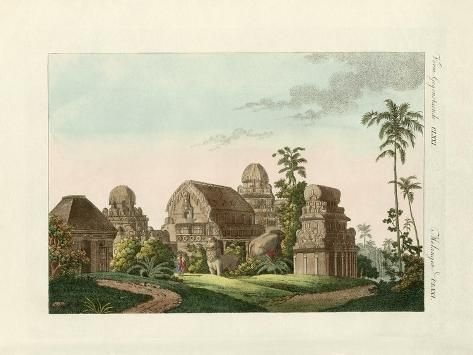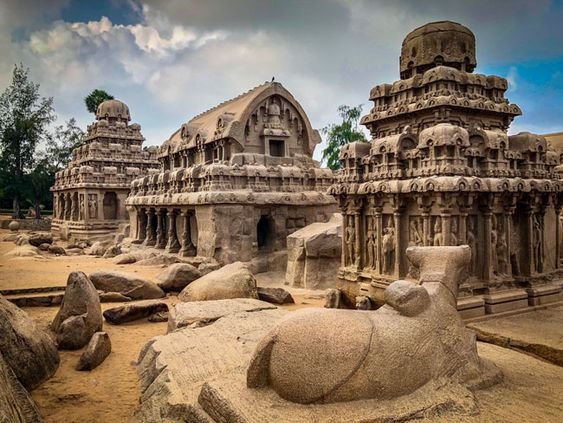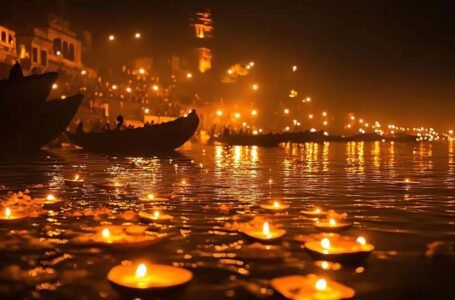“Mahabalipuram” – the Lost & Found city of Mamallapuram

“Mahabalipuram” is the ancient Indian temple of Tamil Nadu, India.
What do we know about Mahabalipuram?
Mahabalipuram, also known as Mamallapuram, is an ancient Indian temple complex and UNESCO World Heritage Site located in the state of Tamil Nadu, India. It is known for its rock-cut architecture and intricate stone carvings and is believed to have been built during the 7th and 8th centuries AD during the reign of the Pallava dynasty. The site is believed to have been a major centre for pilgrimage, trade, and maritime activity during ancient times. The temples at Mahabalipuram are primarily dedicated to Lord Shiva and are notable for their monolithic rock-cut structures, including the famous “Shore Temple” which is one of the oldest structural temples in South India. The temples are also known for their intricate carvings and sculptures, which depict scenes from Hindu mythology, as well as images of gods, goddesses, and animals. Mahabalipuram is a major tourist attraction and is visited by thousands of people every year.

The History of Mahabalipuram
Mahabalipuram, also known as Mamallapuram, is an ancient Indian temple complex located in the state of Tamil Nadu, India. The history of Mahabalipuram can be traced back to the 7th and 8th centuries AD, during the reign of the Pallava dynasty. The Pallavas were a powerful dynasty that ruled over a large part of South India, and they are known for their contributions to art, architecture, and culture.
The Pallava king Narasimhavarman I, also known as Mamalla, is credited with building many of the temples and monuments at Mahabalipuram. He is believed to have been a patron of the arts and a great builder, and his reign is considered to be the golden age of Mahabalipuram. He built many of the rock-cut temples and monuments, including the famous “Shore Temple” which is one of the oldest structural temples in South India.

Mahabalipuram continued to flourish under the Pallavas, and many other temples and monuments were built during this time, including the famous “Five Rathas” and the “Arjuna’s Penance” relief sculpture. The site also served as an important centre for trade, maritime activity, and pilgrimage, and it was a major cultural and intellectual hub during ancient times.
After the fall of the Pallava dynasty, Mahabalipuram went into decline and many of the temples and monuments fell into disrepair. However, in the 19th century, the British archaeologist Alexander Rea began to study and restore the site, and it was eventually declared a UNESCO World Heritage Site in 1984. Today, Mahabalipuram is a major tourist attraction and is visited by thousands of people every year.

The significance of Mahabalipuram
Mahabalipuram, also known as Mamallapuram, is an ancient Indian temple complex and UNESCO World Heritage Site located in the state of Tamil Nadu, India. It is considered to be of great historical and cultural significance for several reasons:
Rock-cut architecture: The temples at Mahabalipuram are some of the oldest examples of rock-cut architecture in India, and they demonstrate the skill and craftsmanship of the ancient Indian builders.

Intricate carvings and sculptures: The temples are adorned with intricate carvings and sculptures that depict scenes from Hindu mythology, as well as images of gods, goddesses, and animals. These carvings and sculptures are considered to be masterpieces of ancient Indian art and are admired for their beauty and craftsmanship.
Historical significance: Mahabalipuram was a major centre for trade, maritime activity, and pilgrimage during ancient times, and it played an important role in the development of South Indian culture and civilization.
UNESCO World Heritage Site: Mahabalipuram was declared a UNESCO World Heritage Site in 1984. This designation recognizes the site’s cultural and historical significance and helps to protect and preserve it for future generations.
Tourist attraction: Mahabalipuram is a major tourist attraction and it is visited by thousands of people every year. It is a place of great historical, cultural and architectural importance and it can provide an insight into the ancient Indian civilization and culture.

The city inhabitants of Mahabalipuram
Mahabalipuram, also known as Mamallapuram, was an ancient Indian temple complex and UNESCO World Heritage Site located in the state of Tamil Nadu, India. The city’s inhabitants during its peak period, in the 7th and 8th centuries AD, were primarily the Pallavas, a powerful dynasty that ruled over a large part of South India. The Pallavas were known for their contributions to art, architecture, and culture, and they were the builders of many of the temples and monuments at Mahabalipuram.
Additionally, the city was a major centre for trade, maritime activity, and pilgrimage during ancient times, so it would have had a diverse population of merchants, sailors, traders, and pilgrims coming from different parts of India and other countries. The inhabitants of Mahabalipuram would have been primarily Hindu, and they would have been involved in various activities such as farming, fishing, and craftsmanship, to support the economy and the city.
It’s worth noting that after the fall of the Pallava dynasty, Mahabalipuram went into decline, and the city’s inhabitants moved to other places. However, in the 19th century, the British archaeologist Alexander Rea began to study and restore the site, and it was eventually declared a UNESCO World Heritage Site in 1984. Today, Mahabalipuram is a major tourist attraction and is visited by thousands of people every year.
The city demise
The exact cause of the demise of the ancient Indian city of Mahabalipuram, also known as Mamallapuram, is not well-documented. However, it is believed that the city went into decline after the fall of the Pallava dynasty, which ruled over South India and was the builder of many of the city’s temples and monuments during the 7th and 8th centuries AD.
Some historians suggest that the city’s decline was caused by a combination of factors, including political instability, invasions by foreign powers, and economic factors such as the silting up of the nearby port, which would have made it difficult for ships to dock and trade. Additionally, the inhabitants of the city may have moved to other places in search of better opportunities.
It’s also worth noting that many of the temples and monuments at Mahabalipuram fell into disrepair over time, due to neglect and the natural elements, however, in the 19th century, the British archaeologist Alexander Rea began to study and restore the site, and it was eventually declared a UNESCO World Heritage Site in 1984. Today, Mahabalipuram is a major tourist attraction and is visited by thousands of people every year, despite its demise.
The city rediscovery
Mahabalipuram, also known as Mamallapuram, was an ancient Indian temple complex and UNESCO World Heritage Site located in the state of Tamil Nadu, India. After the city’s decline, it went largely unoccupied and many of the temples and monuments fell into disrepair due to neglect and the natural elements. The city was rediscovered in the 19th century by British archaeologist Alexander Rea who began to study and restore the site.
Rea was the first European to conduct excavations in Mahabalipuram, and he was responsible for bringing the site to the attention of the British government and the wider public. He conducted excavations and cleared the site of debris and overgrowth, making it accessible to visitors for the first time in centuries. He also published several books and articles about the site, which helped to raise awareness about its historical and cultural significance.
Other archaeologists, historians, and Indologists also conducted research on the site in the late 19th and early 20th centuries, and their work helped to shed light on the history and culture of the ancient city.
In 1984, Mahabalipuram has declared a UNESCO World Heritage Site, this recognition helped to protect and preserve the site for future generations and also brought it to the attention of the world. Today, Mahabalipuram is a major tourist attraction and is visited by thousands of people every year.

Conclusion
In conclusion, Mahabalipuram, also known as Mamallapuram, is an ancient Indian temple complex and UNESCO World Heritage Site located in the state of Tamil Nadu, India. It is known for its rock-cut architecture and intricate stone carvings and is believed to have been built during the 7th and 8th centuries AD during the reign of the Pallava dynasty. The Pallavas were a powerful dynasty that ruled over a large part of South India, and they are known for their contributions to art, architecture, and culture.
Mahabalipuram was a major centre for trade, maritime activity, and pilgrimage during ancient times, and it played an important role in the development of South Indian culture and civilization. The city went into decline after the fall of the Pallava dynasty, however, it was rediscovered in the 19th century by British archaeologist Alexander Rea who began to study and restore the site. His work helped to raise awareness about its historical and cultural significance and eventually in 1984 it was declared a UNESCO World Heritage Site.
Today, Mahabalipuram is a major tourist attraction and is visited by thousands of people every year. It is a place of great historical, cultural and architectural importance and it provides an insight into the ancient Indian civilization and culture.


